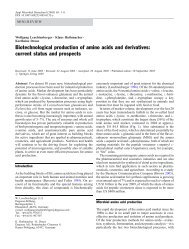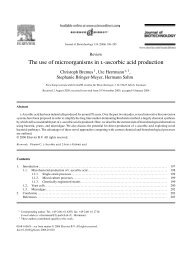The yeast Kluyveromyces marxianus and its ... - It works!
The yeast Kluyveromyces marxianus and its ... - It works!
The yeast Kluyveromyces marxianus and its ... - It works!
You also want an ePaper? Increase the reach of your titles
YUMPU automatically turns print PDFs into web optimized ePapers that Google loves.
340 Appl Microbiol Biotechnol (2008) 79:339–354<br />
Jörgensen, were very closely related, they were considered<br />
distinct species (Lodder <strong>and</strong> Kreger-van Rij 1952). In 1951,<br />
Luh <strong>and</strong> Phaff affirmed that S. fragilis “is the only <strong>yeast</strong><br />
species capable of attacking pectin” (Lodder <strong>and</strong> Kreger-van Rij<br />
1952). Yoghurt, soft cheese, a lung with tuberculosis, Koumiss<br />
(a beverage made of fermented mare’s milk), a human lesion<br />
of tonsils <strong>and</strong> the pharynx, <strong>and</strong> feces are other habitats from<br />
which the 11 strains belonging to the S. fragilis species had<br />
been obtained from (Lodder <strong>and</strong> Kreger-van Rij 1952).<br />
Mainly due to differences in spore <strong>and</strong> ascus morphology,<br />
in the capacity of fermenting <strong>and</strong> oxidizing different<br />
sugars, <strong>and</strong> in the occurrence of hybridization between<br />
strains, when compared to true Saccharomyces <strong>yeast</strong>s, there<br />
was a need to reclassify the former species S. fragilis <strong>and</strong> S.<br />
<strong>marxianus</strong>, besides Saccharomyces lactis, into a new taxon<br />
(van der Walt 1970). In 1956, van der Walt described the<br />
new genus <strong>Kluyveromyces</strong>, the type species of which was<br />
<strong>Kluyveromyces</strong> polysporus (van der Walt 1956). Later, it<br />
was found that the latter <strong>yeast</strong> had very similar properties to<br />
the three above-mentioned species, <strong>and</strong> consequently, they<br />
were all reclassified into the genus <strong>Kluyveromyces</strong>, which<br />
encompassed 18 species in the second edition of <strong>The</strong><br />
Yeasts, a taxonomic study (Lodder 1970). Additional<br />
habitats from which strains had been isolated include Bantu<br />
Beer, milk of a mastitic cow, asthmatic expectoration, <strong>and</strong><br />
maize meal (van der Walt 1970). Again, <strong>Kluyveromyces</strong><br />
fragilis was considered closely related but still separate<br />
from K. <strong>marxianus</strong>, mainly due to the former’s high<br />
capacity of fermenting lactose. Dairy products <strong>and</strong> human<br />
<strong>and</strong> animal lesions were the prevalent origin of strains in<br />
the K. fragilis taxon (van der Walt 1970).<br />
In the third edition of <strong>The</strong> Yeasts, a taxonomic study<br />
(Kreger-van Rij 1984), the genus <strong>Kluyveromyces</strong> was<br />
divided into 11 species. On the basis of interfertility, the<br />
taxon K. <strong>marxianus</strong> was organized into seven varieties,<br />
which are able to readily hybridize (van der Walt <strong>and</strong><br />
Johannsen 1984). Concomitantly, the former species K.<br />
fragilis <strong>and</strong> K. lactis disappeared.<br />
In the most recent edition of <strong>The</strong> Yeasts, a taxonomic study<br />
(Kurtzman <strong>and</strong> Fell 1998), the chapter on the <strong>Kluyveromyces</strong><br />
genus includes 15 species. <strong>The</strong> seven varieties within the K.<br />
<strong>marxianus</strong> species, proposed in the previous edition of the<br />
monograph, were eliminated by considering them as either<br />
independent species (e.g., K. lactis <strong>and</strong> K. dobzhanskii) or<br />
synonyms of K. lactis or K. <strong>marxianus</strong> (Lachance 1998).This<br />
is due to the examination of the genetic structure of<br />
populations, in combination with hybridization ability, as<br />
criteria for classification. Consequently, the former species or<br />
varieties <strong>Kluyveromyces</strong> bulgaricus, K. cicerisporus, K.<br />
fragilis, <strong>and</strong>K. wikenii could not be considered distinct from<br />
K. <strong>marxianus</strong> (Lachance 1998).<br />
Since the biological concept of species cannot be applied<br />
to homothallic organisms, such as the majority of <strong>yeast</strong>s in<br />
the <strong>Kluyveromyces</strong> taxon, any classification is always based<br />
on arbitrary criteria, which have changed along time, as<br />
discussed above. Since the development of rapid <strong>and</strong><br />
efficient gene sequencing tools, it became natural to utilize<br />
gene sequences as the criterion for the comparison <strong>and</strong><br />
classification of microorganisms into the different taxa.<br />
Rather than performing single gene comparisons, the most<br />
recent reports on the taxonomy of <strong>Kluyveromyces</strong> <strong>yeast</strong>s<br />
employ multigene sequence analyses for elucidating the<br />
phylogeny of the different strains. Using this strategy,<br />
Kurtzman <strong>and</strong> Robnett (2003) showed that the species<br />
described by Lachance (1998) in the <strong>Kluyveromyces</strong> genus<br />
are actually distributed into six clades, indicating the<br />
polyphyly of this group of <strong>yeast</strong>s. This is mainly due to<br />
the previous criteria employed in classification, such as<br />
ascus morphology (in this particular case, ascus deliquescence),<br />
which are inadequate as phylogenetic descriptors<br />
(Kurtzman 2003; Kurtzman <strong>and</strong> Robnett 2003). <strong>It</strong> has been<br />
proposed that genera should be circumscribed according to<br />
the phylogenetically defined clades, rather than on phenotypic<br />
analyses (Kurtzman <strong>and</strong> Robnett 2003). As a result of<br />
this, the number of species in the <strong>Kluyveromyces</strong> genus<br />
decreased to six <strong>and</strong> the species K. <strong>marxianus</strong> is proposed<br />
as the conserved type species (Kurtzman 2003; Lachance<br />
2007). <strong>The</strong> type species of the originally described<br />
<strong>Kluyveromyces</strong> genus (van der Walt 1956), namely, K.<br />
polysporus, has been reclassified into the newly proposed<br />
V<strong>and</strong>erwaltozyma genus (Kurtzman 2003; Lachance 2007).<br />
Biochemistry, metabolism, <strong>and</strong> physiology<br />
<strong>It</strong> should be noted that the great majority of studies<br />
published on K. <strong>marxianus</strong> have not aimed at looking into<br />
<strong>its</strong> biochemistry, metabolism, or physiology. Most of the<br />
<strong>works</strong> that are publicly available explored potential applications<br />
of this organism (see “Biotechnological applications”),<br />
without investigating what takes place at the<br />
intracellular level. Typically, the <strong>yeast</strong> cells have been<br />
cultivated on a specific substrate, <strong>and</strong> measurements have<br />
been carried out in such a way that only the concentrations<br />
of a substrate <strong>and</strong> of a product, besides the cell concentration,<br />
are determined. In what concerns physiology, carbon<br />
balances are very rarely looked at, meaning that it is only<br />
possible to have a rough macroscopic picture of the cellular<br />
reactions <strong>and</strong>, hence, of the organism’s physiology.<br />
Since the 1970’s, a number of studies has been published<br />
on biochemical <strong>and</strong> metabolic aspects of different K.<br />
<strong>marxianus</strong> strains (a summary is presented in Table 1).<br />
Some studies were actually aimed at identifying suitable<br />
classification methods for K. <strong>marxianus</strong>, which has always<br />
been a challenging task. <strong>The</strong>se include the observation that,<br />
in contrast to S. cerevisiae, ergosterol is the only sterol





